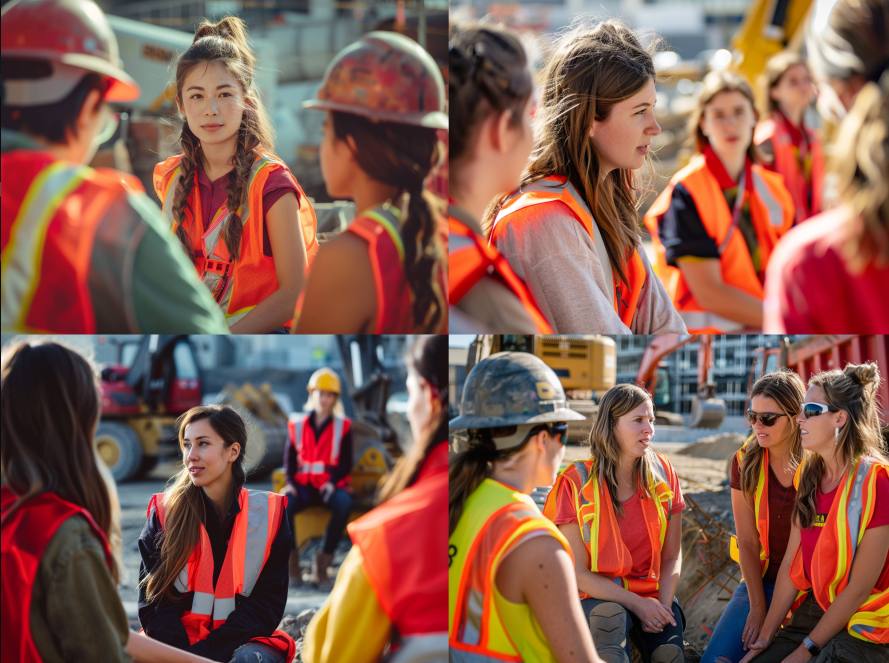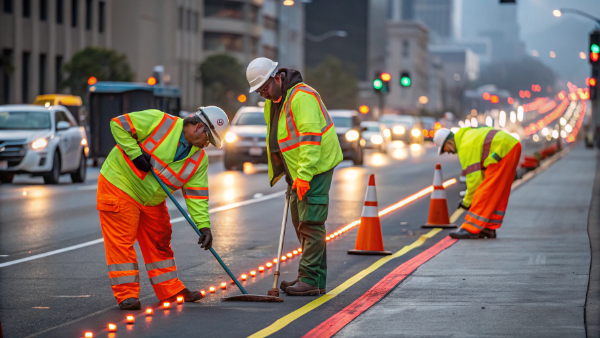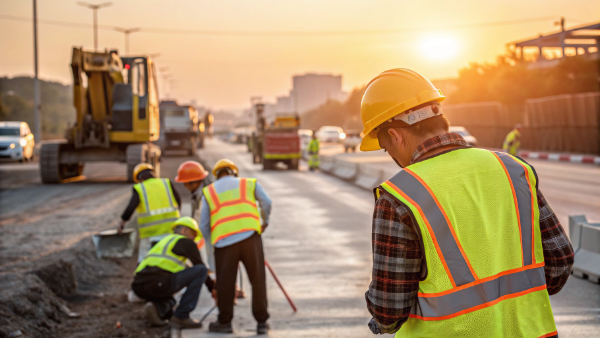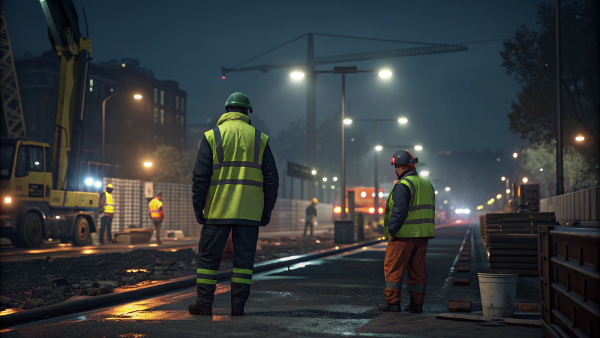Imagine this scenario: You’re managing a construction site or a roadway maintenance crew, and despite your best efforts to ensure safety, accidents still occur. Workers are not easily visible to drivers or machinery operators, especially in low-light conditions. This lack of visibility can lead to severe injuries or even fatalities. The stress and responsibility of ensuring everyone’s safety weigh heavily on your shoulders, and you’re constantly worried about the potential for disaster. Now, what if there were a simple, yet highly effective solution to significantly reduce these risks? Enter safety vests – a crucial piece of personal protective equipment (PPE) that can enhance visibility, improve safety, and ultimately save lives.

The Importance of Safety Vests
Safety vests play a crucial role in enhancing visibility and safety across various professions and activities. Here is an ultimate guide to understanding, choosing, and maintaining safety vests.
Improve Visibility
Safety vests increase the wearer's visibility, especially in low light or adverse weather conditions. The use of bright colors and reflective materials helps prevent accidents by making the wearer more noticeable to others, such as drivers and machinery operators. This visibility is essential for preventing accidents and ensuring that workers are seen from a distance, reducing the risk of collisions and injuries.
Easy Identification
High-visibility vests make it easier to identify workers, especially in busy environments like construction sites or during traffic management. This can improve coordination and communication among team members. Easy identification ensures that everyone knows who is responsible for different tasks, which can streamline operations and enhance overall efficiency.
Promote Safety Awareness
Wearing a safety vest serves as a constant reminder to both the wearer and those around them to stay alert and prioritize safety. This heightened awareness can help prevent accidents and create a safer working environment. When workers are constantly reminded of safety protocols, they are more likely to follow them, leading to fewer accidents and injuries.
Types of Safety Vests
Class 1 Safety Vests
Usage: Low-traffic areas with speeds below 25 MPH.
Features: Minimum of 155 square inches of reflective tape, typically in yellow or orange. These vests are designed for environments where traffic is light and speeds are low, such as parking lots, warehouses, and sidewalk maintenance areas. They provide basic visibility and are suitable for workers who are not exposed to significant traffic risks.
Class 2 Safety Vests
Usage: Higher risk environments where traffic is at or below 50 MPH.
Features: Minimum of 775 square inches of yellow or orange fabric with 201 square inches of reflective tape. These vests are intended for use in environments where traffic speeds are higher and the risk of accidents is greater, such as road construction sites, utility work areas, and railway operations. The increased reflective material and brighter colors enhance visibility, making workers more noticeable to drivers and machinery operators.
Class 3 Safety Vests
Usage: High-risk environments with high-speed traffic.
Features: Provide the most visibility with extensive reflective tape and high-visibility fabric. These vests are designed for the most hazardous environments, where traffic speeds exceed 50 MPH, or where visibility conditions are poor. They offer maximum visibility and are often used by emergency responders, roadway construction teams, and utility workers in high-speed traffic areas.
Choosing the Right Safety Vest
Fabric
Options: Cotton, polyester, or specialized fabrics offering flame or water resistance.
Considerations: Choose based on the work environment and comfort needs. For instance, cotton vests may be more comfortable in hot weather, while polyester vests are more durable and resistant to wear and tear. Specialized fabrics, such as flame-resistant or water-resistant materials, are essential for workers in specific industries, such as firefighting or outdoor construction.
Season
Warm Weather: Opt for breathable materials for comfort during summer or spring. Lightweight fabrics like mesh allow for better airflow, keeping workers cool and comfortable.
Cold Weather: Consider vests that can be worn over heavier clothing. Insulated vests or those with additional layers can provide warmth while still maintaining visibility.
Features
Pockets: Useful for carrying tools, pens, and cell phones. Pockets add functionality to the vest, allowing workers to keep essential items within easy reach.
Closure Types: Velcro or zippers for ease of use and convenience. Velcro closures are quick and easy to use, while zippers provide a more secure fit.
Additional Options: Sashes or wrist and ankle bands for added visibility without full torso coverage. These options can enhance visibility in specific areas, such as the arms and legs, without adding bulk.
Design Preferences
Styles: Camo, multicolored, or tailored designs for specific needs. Different styles can cater to various industries and personal preferences.
Gender-Specific: Adjustable vests for women to ensure a better fit and comfort. Gender-specific designs can provide a more comfortable and secure fit, enhancing overall safety and effectiveness.
Maintenance of Safety Vests
Cleaning
Hand Washing: Use cold water and neutral detergent. Avoid bleach and dry-cleaning. Hand washing is gentle on the fabric and helps maintain the vest's reflective properties.
Machine Washing: Use cold water and the delicate setting. Turn the vest inside out and avoid washing with rough fabrics. Machine washing can be convenient but should be done carefully to prevent damage.
Drying
Air Drying: Hang in the shade to avoid UV damage. Air drying is the safest method to preserve the reflective material and fabric integrity.
Machine Drying: Use the lowest heat setting and remove promptly to prevent damage to reflective materials. If machine drying is necessary, it should be done with caution to avoid overheating and damaging the vest.
What Do the Different Color Safety Vests Mean?
Safety vests come in various colors, each serving a specific purpose and indicating different roles or levels of visibility required in various work environments. Here’s a breakdown of the meanings associated with different safety vest colors:
Common Safety Vest Colors and Their Meanings
Orange: This is the most recognized color for safety vests, commonly worn by construction workers, utility workers, and highway maintenance crews. It provides high visibility against most backgrounds, especially in outdoor settings. Orange vests are highly visible during the day and in low-light conditions, making them ideal for outdoor work.
Yellow/Lime: Often used in similar contexts as orange, yellow or lime safety vests are frequently seen on school crossing guards and traffic control officers. They also meet ANSI visibility standards. Yellow/lime vests are particularly effective in foggy or low-light conditions, as the bright color stands out against most backgrounds.
Red: Typically worn by emergency responders, including firefighters and medical personnel, red vests signify authority and alertness in potentially hazardous situations. Red vests are easily recognizable and convey a sense of urgency and authority.
Green: Used by surveyors, landscapers, and safety personnel, green vests are often seen in contexts where visibility is needed but ANSI compliance is not strictly required. Green vests provide visibility while blending in with natural surroundings, making them suitable for outdoor work like landscaping and surveying.
Blue: Usually worn by police officers and security personnel, blue safety vests are not ANSI-approved but help identify individuals in authority roles, especially in public safety contexts. Blue vests indicate a presence of law enforcement or security, providing a sense of safety and order.
Purple: Often associated with hazardous materials teams, purple vests indicate specialized roles in emergency response situations. Purple vests are used to distinguish workers involved in handling hazardous materials, ensuring they are easily identifiable.
Black: While not typically used for high visibility, black vests can be worn by security personnel and are designed to conceal dirt while still providing some level of visibility. Black vests are practical for security roles where high visibility is not the primary concern.
Pink: These vests are used for events promoting social causes, such as Breast Cancer Awareness, and are often tailored to fit women’s shapes. Pink vests are used to draw attention to specific causes or events, providing visibility while also conveying a message.
Compliance and Standards
Many safety vests must meet ANSI (American National Standards Institute) requirements, especially in environments where visibility is critical, such as construction sites and roadways. Different classes of vests (Class 1, Class 2, Class 3) specify the minimum amount of high-visibility material and reflective tape required, depending on the traffic conditions and work environment.
Conclusion
Choosing the right color safety vest is essential for ensuring visibility and safety in various work settings. Each color not only enhances visibility but also communicates specific roles and responsibilities, which is crucial in maintaining safety standards on job sites.
What's the Difference Between Class 1, 2, and 3 Safety Vests?
The main differences between Class 1, 2, and 3 safety vests are based on the level of visibility they provide and the work environments they're designed for:
Class 1 Safety Vests:
Lowest Level of Visibility: Class 1 vests provide the minimum amount of visibility required for low-risk environments.
For Low-Risk Environments: These vests are suitable for areas with traffic speeds below 25 mph, such as parking lots, warehouses, and sidewalk maintenance.
Minimum of 155 Square Inches of Reflective Tape: The reflective tape enhances visibility but is limited compared to higher-class vests.
Typical Users: Parking lot attendants, warehouse workers, and sidewalk maintenance personnel.
Class 2 Safety Vests:
Moderate Level of Visibility: Class 2 vests offer more visibility than Class 1 vests, making them suitable for higher-risk environments.
For Environments with Traffic Speeds Between 25-50 mph: These vests are designed for areas where traffic speeds are moderate, such as road construction sites and utility work areas.
Minimum of 201 Square Inches of Reflective Tape: The increased amount of reflective tape enhances visibility significantly.
At Least 775 Square Inches of High-Visibility Fabric: The fabric is typically yellow or orange, providing high visibility.
Suitable for Road Construction, Utility Workers, and Railway Workers: These vests are commonly used by workers exposed to moderate traffic risks.
Class 3 Safety Vests:
Highest Level of Visibility: Class 3 vests provide the maximum amount of visibility, making them suitable for the most hazardous environments.
For High-Risk Environments with High-Speed Traffic: These vests are designed for areas where traffic speeds exceed 50 mph or where visibility conditions are poor.
Minimum of 310 Square Inches of Reflective Tape: The extensive reflective tape ensures maximum visibility.
At Least 1,240 Square Inches of High-Visibility Fabric: The fabric provides extensive coverage, often resembling a short-sleeve t-shirt more than a traditional vest.
Used by Emergency Responders, Roadway Construction Teams, and Utility Workers in High-Speed Traffic Areas: These vests are essential for workers exposed to significant traffic risks.
The key factors that differentiate these classes are the amount of reflective tape, the square inches of high-visibility fabric, and the intended work environment based on traffic speed and risk level. As the class number increases, so does the visibility and protection provided by the vest, making it suitable for more hazardous work conditions.
What is an OSHA Approved Safety Vest?
An OSHA-approved safety vest is a high-visibility garment that meets specific standards to ensure worker safety in environments where visibility is crucial. Here are the key characteristics of an OSHA-approved safety vest:
Visibility
The vest must make the worker visible from a minimum of 1,000 feet away. This is achieved through the use of bright, fluorescent colors and reflective materials. High visibility is essential for ensuring that workers are seen from a distance, reducing the risk of accidents.
Colors
Typically, OSHA-approved vests come in fluorescent yellow-green, orange, or red. These colors are chosen for their high visibility in various lighting conditions. The bright colors stand out against most backgrounds, making workers easily noticeable.
Reflective Material
The vest must incorporate retroreflective materials, usually in the form of strips or patterns, to enhance visibility in low-light conditions or at night. Reflective materials are crucial for ensuring visibility in low-light conditions, such as dawn, dusk, or nighttime.
ANSI/ISEA Compliance
OSHA refers to the American National Standards Institute (ANSI) and International Safety Equipment Association (ISEA) standards for specific requirements. The current standard is ANSI/ISEA 107-2020. Compliance with these standards ensures that the vest meets specific performance criteria for visibility and durability.
Classification
OSHA-approved vests are categorized into different classes based on the level of visibility required:
Class 1: For low-risk environments with vehicle speeds under 25 mph.
Class 2: For moderate-risk environments with vehicle speeds up to 50 mph.
Class 3: For high-risk environments with vehicle speeds over 50 mph or poor visibility conditions.
Design Features
Removability: The vest should have Velcro or snap enclosures for easy removal if snagged. This feature ensures that the vest can be quickly removed in case of an emergency.
Functionality: The design should allow for easy access to other safety equipment or tools the worker might need. Functional design features, such as pockets and mic tabs, enhance the vest's usability.
Application
OSHA requires high-visibility safety apparel for workers exposed to traffic in construction zones, on roadways, or in other areas with moving vehicles or equipment. The use of OSHA-approved vests ensures that workers are visible and protected in potentially hazardous environments.
Material
The vests are typically made of breathable mesh material to ensure comfort during extended wear. Breathable materials are essential for maintaining comfort, especially during long work hours or in hot weather conditions.
By meeting these requirements, an OSHA-approved safety vest helps ensure that workers are visible and protected in potentially hazardous environments where vehicle traffic or moving equipment poses a risk.
What is the ANSI Standard for Safety Vests?
The ANSI (American National Standards Institute) standard for safety vests is outlined in the ANSI/ISEA 107-2020 standard, which specifies the requirements for high-visibility safety apparel and headwear. This standard categorizes safety vests into three classes based on the level of visibility and the type of work environment. Here’s a detailed breakdown:
Class 1 Safety Vests
Usage: Low-risk environments with traffic speeds below 25 mph.
Visibility Requirements:
- Minimum of 155 square inches of reflective tape.
- Typically made of bright, high-visibility colors like safety yellow or safety orange.
Examples of Use: Parking lot attendants, warehouse workers, and sidewalk maintenance personnel.
Class 2 Safety Vests
Usage: Moderate-risk environments where traffic speeds are up to 50 mph.
Visibility Requirements:
- Minimum of 201 square inches of reflective tape.
- At least 775 square inches of high-visibility background material (yellow or orange).
- Reflective stripes that run horizontally around the torso and vertically over the shoulders.
Examples of Use: Road construction workers, utility workers, survey crews, airport ground crews, and school crossing guards.
Class 3 Safety Vests
Usage: High-risk environments with high-speed traffic (over 50 mph) or poor visibility conditions.
Visibility Requirements:
- Minimum of 310 square inches of reflective tape.
- At least 1,240 square inches of high-visibility background material.
- Extensive coverage, often resembling a short-sleeve t-shirt more than a traditional vest.
Examples of Use: Emergency responders, roadway construction teams, utility workers in high-speed traffic areas, and tow truck operators working in extreme weather conditions.
Key Features Across All Classes
High-Visibility Colors: Typically fluorescent yellow-green, orange, or red.
Reflective Material: Retroreflective strips to enhance visibility in low-light conditions.
Design: May include additional features like pockets, zippers, and mic tabs for functionality.
Compliance
ANSI/ISEA 107-2020: The current standard that specifies the performance requirements for high-visibility safety apparel. This includes criteria for color, retroreflectivity, and minimum areas of high-visibility materials.
OSHA Requirements: OSHA mandates the use of high-visibility safety apparel for workers exposed to public traffic or construction site vehicles, referencing the ANSI/ISEA standards.
By adhering to these standards, safety vests ensure that workers are visible and protected in various work environments, thereby enhancing overall safety and reducing the risk of accidents.
What is a Type 2 Safety Vest?
A Type 2 safety vest, more commonly referred to as a Class 2 safety vest, is a high-visibility garment designed for moderate-risk work environments. Here are the key characteristics of a Class 2 safety vest:
Visibility Level
Class 2 vests provide a higher level of visibility than Class 1 vests, but less than Class 3. They are designed to ensure that workers are visible in moderately hazardous environments, providing an essential layer of protection for those working near moving vehicles or equipment.
Usage
These vests are intended for use in environments where traffic speeds are between 25-50 mph. They are suitable for areas where traffic speeds are moderate, such as road construction sites, utility work areas, and railway operations.
Reflective Material
Class 2 vests must have a minimum of 201 square inches of reflective tape. The increased amount of reflective tape enhances visibility significantly, making workers more noticeable to drivers and machinery operators.
Background Material
They require at least 775 square inches of high-visibility background material, typically in fluorescent yellow-green or orange. The bright colors stand out against most backgrounds, making workers easily noticeable.
Design
Class 2 vests usually feature reflective stripes that run horizontally around the torso and vertically over the shoulders. The design ensures maximum visibility from all angles, enhancing safety.
Typical Users
Road construction workers, utility workers, survey crews, airport ground crews, and school crossing guards often wear Class 2 vests. These vests are commonly used by workers exposed to moderate traffic risks.
ANSI/ISEA Standard
These vests comply with the ANSI/ISEA 107-2020 standard for high-visibility safety apparel. Compliance with these standards ensures that the vest meets specific performance criteria for visibility and durability.
Features
Many Class 2 vests include additional features like pockets, zippers, and mic tabs for added functionality. Functional design features enhance the vest's usability, making it suitable for various occupations and work settings.
Class 2 safety vests are designed to ensure that workers are visible in moderately hazardous environments, providing an essential layer of protection for those working near moving vehicles or equipment. They offer a balance between visibility and comfort, making them suitable for a wide range of occupations and work settings.
What is the Difference Between Type 1 and Type 2 Life Vests?
The difference between Type 1 and Type 2 life vests primarily lies in their intended use and the level of buoyancy they provide. Here's a detailed comparison:
Type 1 Life Vests
Intended Use: Designed for offshore and rough waters where rescue may take a while. Type 1 life vests are suitable for ocean sailing, commercial vessels, and situations where help might be delayed.
Buoyancy: Provides the highest level of buoyancy, typically around 22 pounds for adults. The high buoyancy ensures that the wearer remains afloat, even in rough waters.
Design: Bulky and designed to turn an unconscious person face-up in the water. The design ensures that the wearer’s airway remains clear of the water, reducing the risk of drowning.
Visibility: Often brightly colored with reflective materials to enhance visibility. The bright colors and reflective materials make the wearer easily noticeable to rescuers.
Applications: Ideal for ocean sailing, commercial vessels, and situations where
Type 2 Life Vests
Intended Use: Suitable for calm, inland waters where quick rescue is likely. Type 2 life vests are commonly used for boating on lakes and rivers, and for general recreational use.
Buoyancy: Provides moderate buoyancy, usually around 15.5 pounds for adults. While they offer less buoyancy than Type 1 vests, they are still effective in keeping the wearer afloat.
Design: Less bulky than Type 1, but may not always turn an unconscious person face-up. The design is more streamlined, making it more comfortable for extended wear.
Visibility: Typically bright and may include some reflective materials. These vests are designed to be easily seen in various lighting conditions.
Applications: Commonly used for boating on lakes and rivers, and for general recreational use. They are ideal for situations where rescue is expected to be quick.
Summary
Type 1 Life Vests: Best for offshore, rough waters, and situations where rescue may be delayed. They offer the highest buoyancy and are designed to turn unconscious wearers face-up.
Type 2 Life Vests: Suitable for calm, inland waters with a high likelihood of quick rescue. They provide moderate buoyancy and are less bulky, but may not always turn unconscious wearers face-up.
Choosing the appropriate life vest depends on the specific water conditions and the likelihood of rescue.
Conclusion
Safety vests are an indispensable component of personal protective equipment, significantly enhancing visibility and safety across various professions and activities. From construction sites to emergency response scenarios, the right safety vest can make a crucial difference in preventing accidents and saving lives. By understanding the different classes of safety vests, their specific applications, and the importance of maintenance, you can ensure that your team is adequately protected.
Selecting the appropriate safety vest involves considering factors such as the work environment, fabric, season, and additional features that cater to specific needs. Compliance with standards like OSHA and ANSI ensures that the vests meet rigorous safety requirements, providing peace of mind for both employers and employees.
Moreover, the color of safety vests plays a vital role in identifying roles and responsibilities on the job site, further contributing to a safer and more organized working environment. Understanding the distinctions between Class 1, 2, and 3 safety vests helps in making informed decisions that align with the risk levels of different work environments.
In summary, safety vests are more than just a piece of clothing; they are a critical safety measure that protects workers in various hazardous conditions. By choosing the right vest and maintaining it properly, you can create a safer, more efficient workplace where visibility and safety are prioritized. Whether you are a production manager, office buyer, or distributor, investing in high-quality, compliant safety vests is a strategic decision that underscores your commitment to safety and excellence.



